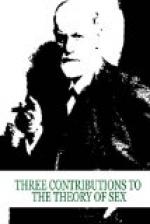Fixation.—The influence of the psychic factors just mentioned favored the development of the accidentally experienced impulses of the infantile sexuality. The latter (especially in the form of seductions through other children or through adults) produce the material which, with the help of the former, may become fixed as a permanent disturbance. A considerable number of the deviations from the normal sexual life observed later have been thus established in neurotics and perverts from the beginning through the impressions received during the alleged sexually free period of childhood. The causation is produced by the responsiveness of the constitution, the prematurity, the quality of heightened adhesion, and the accidental excitement of the sexual impulse through outside influence.
The unsatisfactory conclusions which have resulted from this investigation of the disturbances of the sexual life is due to the fact that we as yet know too little concerning the biological processes in which the nature of sexuality consists to form from our isolated examinations a satisfactory theory for the explanation of either the normal or the pathological.
[1] The differences will be emphasized in the schematic representation given in the text. To what extent the infantile sexuality approaches the definitive sexual organization through its object selection has been discussed before (p. 60).
[2] See my work, Wit and its Relation to the Unconscious, translated by A.A. Brill, Moffat Yard Pub. Co., New York: “The fore-pleasure gained by the technique of wit is utilized for the purpose of setting free a greater pleasure by the removal of inner inhibitions.”
[3] Cf. Zur Einfuehrung des Narzismus, Jahrbuch der Psychoanalyse, VI, 1913.
[4] It is necessary to make clear that the conceptions “masculine” and “feminine,” whose content seems so unequivocal to the ordinary meaning, belong to the most confused terms in science and can be cut up into at least three paths. One uses masculine and feminine at times in the sense of activity and passivity, again, in the biological sense, and then also in the sociological sense. The first of these three meanings is the essential




